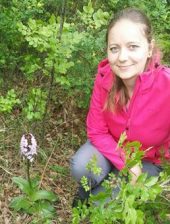Ecology is the science about interactions, which define distributions of organisms, their abundances, and why they are found there. Ecologists study interactions between organisms and their environment on many different scales: from a single organism to the complex interactions within diverse communities; from a microhabitat of a rock crevice to the biomes of the Earth. Answers for mentioned questions where?, how many?, why? are important for understanding current, elucidating past and predicting future ecological processes.
What does ecology have to do with each one of us?
Numerous fields within ecology (e.g. population, landscape, functional, theoretical ecology) and its interdisciplinarity (with e.g. biogeography, evolution, genetics) help us to understand and improve our environment, as well as to protect natural resources and manage them in a sustainable way.
Our research topics are also subjects of student theses. We collaborate with researchers from Slovenia and abroad.
We study occurrences of non-native, invasive species, their invasiveness and invasibility of their habitats in the introduced range. More recently, we seek to understand the interactions between native and non-native species, as well as interactions among non-native species.
More:
https://doi.org/10.3391/bir.2019.8.3.06
https://doi.org/10.3391/mbi.2020.11.4.08

We study mostly plant species or special plant functional groups (e.g. rare endemic Hladnikia pastinacifolia, invasive Pistia stratiotes, model species’ Glechoma hederacea and Alliaria petiolata, halophytes Salicornia sp., Centaurea pumilio) by investigating their reproductive potential, phenotypic plasticity, ecophysiology, co-existence and persistence. Recently we became interested in ecological roles of selected animal species (e.g. leaf miner Cheliosia fasciata).
More:
https://doi.org/10.1080/23818107.2020.1765196
https://doi.org/10.1080/11263504.2020.1727981
https://doi.org/10.3161/15052249PJE2017.65.1.005

We perform various kinds of experiments in the field and lab to study seed ecology (e.g. germination manipulation, seed banks studies). Further on, we study effects of abiotic and biotic stress on plants through monitoring their anatomical, morphological and physiological responses.
More:
https://doi.org/10.2478/botcro-2019-0017

We are interested in understanding ecological processes behind the co-existence mechanisms and biodiversity patterns with mathematical models
More:
https://doi.org/10.1016/j.ecolmodel.2013.12.00
https://doi.org/10.1016/j.landurbplan.2017.02.012




